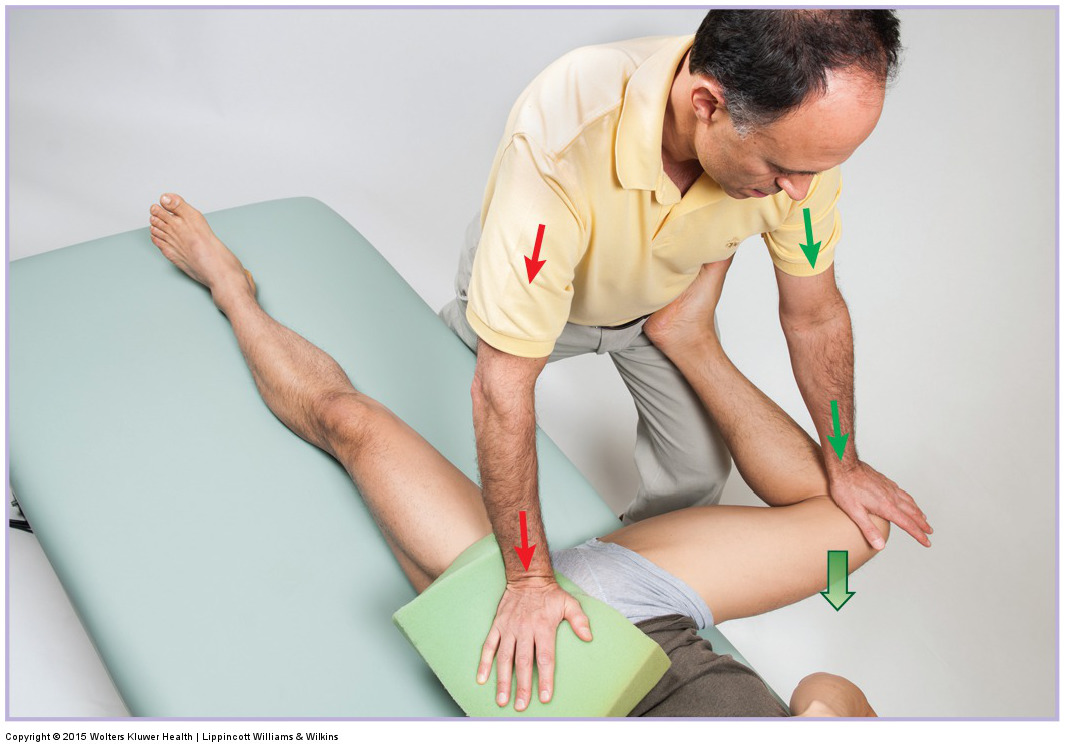Manual therapy treatment for an adductor strain (groin pull):
The appropriate manual therapy treatment for an adductor strain (groin pull) depends on whether it is acute or chronic. During the acute stage, manual treatment is geared primarily toward reducing the inflammation of the condition. This is accomplished with cryotherapy (ice). If possible, gentle effleurage strokes from distal to proximal might also be helpful. Stretching the adductor musculature by bringing the thigh into abduction (while stabilizing the pelvis) and possibly strengthening of the non-injured side can be done. This has the effect of creating some degree of neural cross-over for the injured side so that less tightness and deconditioning will occur during the acute period of the injury.

Stretching the right-sided adductor musculature. Permission: Joseph E. Muscolino. Manual Therapy for the Low Back and Pelvis: A Clinical Orthopedic Approach (2015).
Once the adductor strain is chronic, which is determined by the restoration of tissue integrity and the absence of swelling, manual therapy treatment should be geared toward decreasing any soft tissue restrictions caused by tightness, myofascial trigger points, or fascial adhesions. This can be accomplished by using moist heat, soft tissue manipulation (massage), and stretching. Both longitudinal and cross fibers strokes can be performed; usually cross fiber strokes are more effective as the tendon is approached. Deep stroking massage and/or sustained compression can be used on the trigger points.
After working on the myofascial tissues, it can be important to address the intrinsic tissues of the hip joint with joint mobilization (also known as arthrofascial stretching). Although it is important to assess and treat all axial and nonaxial restrictions, particular attention should be paid to mobilizing the hip joint into inferior glide because inferior glide accompanies abduction of the thigh, likely the most restricted range of motion at the hip joint.
Summary of Manual Therapy Treatment Protocol for Adductor Strain
| 1. Acute stage: Ice and gentle distal-to-proximal effleurage |
| 2. Stretching and possibly strengthening of the non-injured adductor group. |
| 3. Chronic stage: Moist heat, soft tissue manipulation (especially cross fiber at the tendon region), and stretch |
| 4. Hip joint mobilization (arthrofascial stretching), especially into inferior glide |
Precautions/contraindications:
During the acute stage of an adductor strain, nothing should be done that would increase swelling; therefore, any soft tissue manipulation massage should be gentle in force. If soft tissue manipulation is done to the pectineus, caution must be observed because of the proximity of the femoral nerve, artery, and vein. Because of the region being worked, proper draping is essential for client/patient comfort and modesty. The drape should be tucked under the client’s other thigh; this type of draping is called “diaper draping.”


